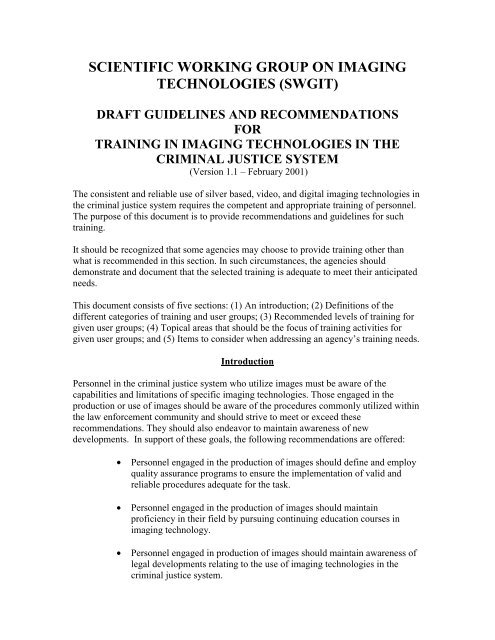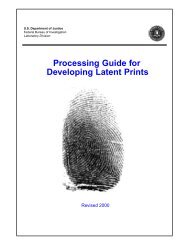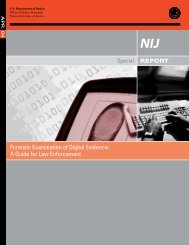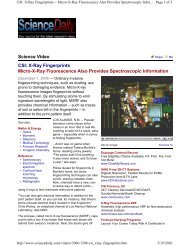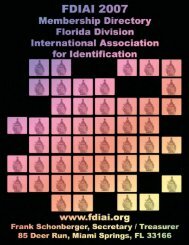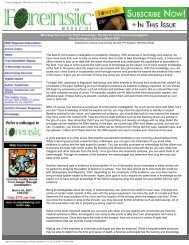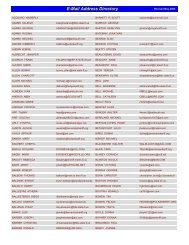scientific working group on imaging technologies (swgit) - the FDIAI
scientific working group on imaging technologies (swgit) - the FDIAI
scientific working group on imaging technologies (swgit) - the FDIAI
You also want an ePaper? Increase the reach of your titles
YUMPU automatically turns print PDFs into web optimized ePapers that Google loves.
SCIENTIFIC WORKING GROUP ON IMAGING<br />
TECHNOLOGIES (SWGIT)<br />
DRAFT GUIDELINES AND RECOMMENDATIONS<br />
FOR<br />
TRAINING IN IMAGING TECHNOLOGIES IN THE<br />
CRIMINAL JUSTICE SYSTEM<br />
(Versi<strong>on</strong> 1.1 – February 2001)<br />
The c<strong>on</strong>sistent and reliable use of silver based, video, and digital <strong>imaging</strong> <strong>technologies</strong> in<br />
<strong>the</strong> criminal justice system requires <strong>the</strong> competent and appropriate training of pers<strong>on</strong>nel.<br />
The purpose of this document is to provide recommendati<strong>on</strong>s and guidelines for such<br />
training.<br />
It should be recognized that some agencies may choose to provide training o<strong>the</strong>r than<br />
what is recommended in this secti<strong>on</strong>. In such circumstances, <strong>the</strong> agencies should<br />
dem<strong>on</strong>strate and document that <strong>the</strong> selected training is adequate to meet <strong>the</strong>ir anticipated<br />
needs.<br />
This document c<strong>on</strong>sists of five secti<strong>on</strong>s: (1) An introducti<strong>on</strong>; (2) Definiti<strong>on</strong>s of <strong>the</strong><br />
different categories of training and user <str<strong>on</strong>g>group</str<strong>on</strong>g>s; (3) Recommended levels of training for<br />
given user <str<strong>on</strong>g>group</str<strong>on</strong>g>s; (4) Topical areas that should be <strong>the</strong> focus of training activities for<br />
given user <str<strong>on</strong>g>group</str<strong>on</strong>g>s; and (5) Items to c<strong>on</strong>sider when addressing an agency’s training needs.<br />
Introducti<strong>on</strong><br />
Pers<strong>on</strong>nel in <strong>the</strong> criminal justice system who utilize images must be aware of <strong>the</strong><br />
capabilities and limitati<strong>on</strong>s of specific <strong>imaging</strong> <strong>technologies</strong>. Those engaged in <strong>the</strong><br />
producti<strong>on</strong> or use of images should be aware of <strong>the</strong> procedures comm<strong>on</strong>ly utilized within<br />
<strong>the</strong> law enforcement community and should strive to meet or exceed <strong>the</strong>se<br />
recommendati<strong>on</strong>s. They should also endeavor to maintain awareness of new<br />
developments. In support of <strong>the</strong>se goals, <strong>the</strong> following recommendati<strong>on</strong>s are offered:<br />
• Pers<strong>on</strong>nel engaged in <strong>the</strong> producti<strong>on</strong> of images should define and employ<br />
quality assurance programs to ensure <strong>the</strong> implementati<strong>on</strong> of valid and<br />
reliable procedures adequate for <strong>the</strong> task.<br />
• Pers<strong>on</strong>nel engaged in <strong>the</strong> producti<strong>on</strong> of images should maintain<br />
proficiency in <strong>the</strong>ir field by pursuing c<strong>on</strong>tinuing educati<strong>on</strong> courses in<br />
<strong>imaging</strong> technology.<br />
• Pers<strong>on</strong>nel engaged in producti<strong>on</strong> of images should maintain awareness of<br />
legal developments relating to <strong>the</strong> use of <strong>imaging</strong> <strong>technologies</strong> in <strong>the</strong><br />
criminal justice system.
Categories of Training<br />
Several categories of <strong>imaging</strong> technology training relevant to <strong>the</strong> criminal justice system<br />
are identified below.<br />
a. Awareness<br />
Training designed to provide <strong>the</strong> student with a general knowledge of <strong>the</strong><br />
major elements of a given <strong>imaging</strong> technology, to include specific product<br />
capabilities.<br />
b. Skills and techniques<br />
Training designed to provide <strong>the</strong> student with <strong>the</strong> ability to competently use<br />
specific <strong>imaging</strong> equipment.<br />
c. Knowledge of processes and relati<strong>on</strong>ships<br />
Training designed to provide <strong>the</strong> student with an understanding of <strong>the</strong> <strong>imaging</strong><br />
technology and <strong>the</strong> ability to apply that technology to various applicati<strong>on</strong>s.<br />
d. Court procedures – witness testim<strong>on</strong>y<br />
Training designed to provide <strong>the</strong> student with <strong>the</strong> ability to present reliable<br />
<strong>imaging</strong> technology-based testim<strong>on</strong>y in court.<br />
e. Court procedures – case preparati<strong>on</strong><br />
Training designed to provide <strong>the</strong> student with <strong>the</strong> ability to prepare and review<br />
accurate and reliable <strong>imaging</strong> technology-based evidence.<br />
f. C<strong>on</strong>tinuing educati<strong>on</strong><br />
Training designed to provide <strong>the</strong> student with additi<strong>on</strong>al and updated training<br />
in <strong>imaging</strong> <strong>technologies</strong>.<br />
g. Specialized applicati<strong>on</strong>s<br />
Training in specific disciplines or in specialized areas.<br />
h. Proficiency<br />
Proficiency Training incorporates a number of comp<strong>on</strong>ents:<br />
1. Required levels of skill and knowledge for a job category should be<br />
identified by <strong>the</strong> agency. These levels should be driven by <strong>the</strong> requirements of<br />
<strong>the</strong> specific tasks to be accomplished.<br />
2. A course of study should be designed by <strong>the</strong> agency, or it’s agent, to<br />
provide <strong>the</strong> skills and informati<strong>on</strong> necessary for <strong>the</strong> agencies pers<strong>on</strong>nel to<br />
attain competency in those skills.<br />
3. If determined to be necessary by <strong>the</strong> agency, a proficiency test should be<br />
developed and administered to test proficiency in <strong>the</strong>se skills.<br />
4. Different levels of proficiency tests may be developed depending <strong>on</strong> <strong>the</strong><br />
level of skill and experience of <strong>the</strong> individual.
Categories of Users<br />
a. Management<br />
Includes individuals resp<strong>on</strong>sible for setting agency policies and/or making<br />
budget decisi<strong>on</strong>s.<br />
b. Command/Supervisi<strong>on</strong><br />
Includes individuals who supervise and/or direct pers<strong>on</strong>nel engaged in <strong>the</strong> use<br />
of <strong>imaging</strong> <strong>technologies</strong>.<br />
c. Law Enforcement Officer<br />
Includes individuals who utilize <strong>imaging</strong> <strong>technologies</strong> as a minor comp<strong>on</strong>ent<br />
of <strong>the</strong>ir routine duties. Note: If <strong>the</strong> individual is routinely involved in <strong>the</strong><br />
basic photographic documentati<strong>on</strong> of crime scenes, <strong>the</strong>n this individual would<br />
fall into <strong>the</strong> category “Crime Scene Technician” (see below).<br />
d. Crime Scene Technician (CST)<br />
Includes individuals for whom <strong>imaging</strong> is a major comp<strong>on</strong>ent of <strong>the</strong>ir routine<br />
duties. Crime Scene Technicians are divided into two categories: “Level 1”<br />
CSTs routinely perform <strong>on</strong>ly basic photographic or videographic<br />
documentati<strong>on</strong> of crime scenes; “Level 2” CSTs routinely utilize forensic<br />
photographic techniques, including specialized photography of impressi<strong>on</strong><br />
evidence.<br />
e. Criminalist/Examiner<br />
Includes individuals for whom <strong>imaging</strong> is a major comp<strong>on</strong>ent of <strong>the</strong>ir routine<br />
duties. These individuals are not <strong>on</strong>ly resp<strong>on</strong>sible for <strong>the</strong> acquisiti<strong>on</strong> of<br />
images as a part of <strong>the</strong>ir duties, but may also be resp<strong>on</strong>sible for <strong>the</strong> analysis of<br />
<strong>the</strong>se images.<br />
f. Photographer/Videographer/Specialist<br />
Includes individuals for whom <strong>imaging</strong> is <strong>the</strong> major comp<strong>on</strong>ent of <strong>the</strong>ir<br />
routine duties.<br />
g. Lawyer<br />
Includes prosecutors and defense attorneys.<br />
h. Judge<br />
Includes individuals resp<strong>on</strong>sible for <strong>the</strong> acceptance or rejecti<strong>on</strong> of <strong>imaging</strong><br />
technology-based evidence in court proceedings.<br />
i. Legal Assistant<br />
Includes individuals resp<strong>on</strong>sible for preparing materials that will be offered in<br />
court proceedings.<br />
j. Trainer
Includes individuals resp<strong>on</strong>sible for providing instructi<strong>on</strong> to o<strong>the</strong>rs in <strong>imaging</strong><br />
technology-related areas.<br />
Recommended Training Levels<br />
The following table provides an assessment of <strong>the</strong> level of training needed for<br />
individuals in each user category, broken out by type of training.<br />
Witness Case C<strong>on</strong>tinuing Specialized Proficiency<br />
Awareness Skills Knowledge Testim<strong>on</strong>y Preparati<strong>on</strong> Educati<strong>on</strong> Applicat’ns Testing<br />
Management High Low Low Low Low Low Low N/A<br />
Command/<br />
N/A<br />
Supervisi<strong>on</strong> High Low Low Medium Low Low Low<br />
Law<br />
Enforcement<br />
Low<br />
Officer Low High Low Low Low Medium Low<br />
Crime Scene<br />
Medium<br />
Technician Low High Medium High Medium High Medium<br />
Criminalist/<br />
High<br />
Examiner Low High Medium High High High High<br />
Photographer/<br />
Videographer/<br />
High<br />
Specialist Medium High High High High High High<br />
Lawyer High Low Medium High High Medium Low N/A<br />
Judge High Low Low Low Low Low Low N/A<br />
Legal Assistant Low High Low Medium Medium Medium Low N/A<br />
Trainer * High * * * High * High<br />
* This will depend <strong>on</strong> <strong>the</strong> levels of training and <strong>the</strong> needs of <strong>the</strong> students.<br />
High - This training and testing is highly recommended for <strong>the</strong> named user <str<strong>on</strong>g>group</str<strong>on</strong>g>.<br />
Medium – This training and testing is recommended for <strong>the</strong> named user <str<strong>on</strong>g>group</str<strong>on</strong>g>.<br />
Low – This training and testing is desirable for <strong>the</strong> named user <str<strong>on</strong>g>group</str<strong>on</strong>g>.<br />
N/A – not applicable
Topical Areas for Focused Training<br />
The following delineates specific topical areas in which given user <str<strong>on</strong>g>group</str<strong>on</strong>g>s should receive<br />
focused training in order to effectively fulfill <strong>the</strong>ir <strong>imaging</strong> technology-related duties.<br />
Managers, Command, Lawyers and Judges<br />
(Awareness and Issues Training)<br />
1. Status of <strong>imaging</strong> technology<br />
a. Legal issues<br />
b. Extent of use and who are <strong>the</strong> users<br />
c. Industry and market trends<br />
2. Descripti<strong>on</strong> of current <strong>technologies</strong><br />
a. Strengths and weaknesses of SI (silver <strong>imaging</strong>)<br />
b. Strengths and weaknesses of DI (digital <strong>imaging</strong>)<br />
c. Strengths and weaknesses of video <strong>imaging</strong> (analog and digital)<br />
d. Current life cycle cost comparis<strong>on</strong>s and limitati<strong>on</strong>s<br />
3. Strategic alternatives for <strong>the</strong> individual agency<br />
a. Determining <strong>imaging</strong> needs<br />
b. Sequencing of equipment/software acquisiti<strong>on</strong>s<br />
c. Acti<strong>on</strong>s to avoid or less<strong>on</strong>s learned<br />
d. References/informati<strong>on</strong> sources<br />
For Legal Assistants<br />
1. Basic levels of skill for recording images.<br />
2. A <str<strong>on</strong>g>working</str<strong>on</strong>g> knowledge of <strong>the</strong> basic fundamentals of photography and/or<br />
videography<br />
3. A <str<strong>on</strong>g>working</str<strong>on</strong>g> knowledge of <strong>the</strong> capabilities and limitati<strong>on</strong>s of equipment<br />
4. Selecti<strong>on</strong> and operati<strong>on</strong> of <strong>the</strong> appropriate cameras (digital, video, or film) and<br />
accessories.<br />
5. Preparing court presentati<strong>on</strong>s, which include images.<br />
For Law Enforcement Officers<br />
(First resp<strong>on</strong>der)<br />
1. Operati<strong>on</strong> of cameras with an understanding of <strong>the</strong> capabilities and limitati<strong>on</strong>s of<br />
<strong>the</strong> equipment that <strong>the</strong>y are assigned as a part of <strong>the</strong>ir routine duties<br />
2. Selecting, framing and composing of appropriate images<br />
3. Procedures for recording quality images in various situati<strong>on</strong>s<br />
4. The proper collecti<strong>on</strong> and preservati<strong>on</strong> of <strong>the</strong> recording media<br />
5. Create and maintain <strong>the</strong> chain of custody<br />
6. Dem<strong>on</strong>strate competence.<br />
7. Dem<strong>on</strong>strate proficiency through testing.
For Crime Scene Technicians and Law Enforcement Officers-Level 1<br />
(With video or adjustable still cameras)<br />
1. Basic levels of skill and knowledge for recording a crime scene<br />
a. Various images to take<br />
b. Set-ups for each type of image<br />
2. A <str<strong>on</strong>g>working</str<strong>on</strong>g> knowledge of <strong>the</strong> fundamentals of photography and/or videography<br />
3. The proper collecti<strong>on</strong> and preservati<strong>on</strong> of <strong>the</strong> recording media<br />
4. Create and maintain <strong>the</strong> chain of custody.<br />
5. A <str<strong>on</strong>g>working</str<strong>on</strong>g> knowledge of <strong>the</strong> capabilities and limitati<strong>on</strong>s of equipment<br />
6. Select and operate <strong>the</strong> appropriate cameras (digital, video, or film) and<br />
accessories.<br />
7. Dem<strong>on</strong>strate competence.<br />
8. Dem<strong>on</strong>strate proficiency through testing.<br />
For <strong>the</strong> Crime Scene Technicians-Level 2<br />
(Capable of training Level 1 and Law Enforcement Officers)<br />
1. Comprehensive knowledge of and experience in forensic photography techniques,<br />
such as:<br />
a. Impressi<strong>on</strong> evidence such as fingerprints, and/or blood spatter.<br />
b. Selecti<strong>on</strong> of <strong>the</strong> appropriate film and equipment based <strong>on</strong> knowledge of <strong>the</strong><br />
capabilities and limitati<strong>on</strong>s of <strong>the</strong> various aspects of <strong>imaging</strong>. Solve difficult<br />
n<strong>on</strong>-routine <strong>imaging</strong> problems.<br />
2. Awareness of film processing and image processing opti<strong>on</strong>s, for example, <strong>the</strong><br />
effects of <strong>the</strong> push process or c<strong>on</strong>trast adjustments.<br />
3. Videography techniques. (refer to LEVA Guidelines at www.leva.org)<br />
4. Know how to use <strong>the</strong> most comm<strong>on</strong> image processing tools and techniques.<br />
5. Dem<strong>on</strong>strate competence.<br />
6. Dem<strong>on</strong>strate proficiency through testing.<br />
For <strong>the</strong> Imaging Specialist- Pers<strong>on</strong>nel include photographic specialists, forensic scientists<br />
and forensic video analysts. These pers<strong>on</strong>nel are capable of training Law Enforcement<br />
Officers and Level 1 and Level 2 Crime Scene Technicians.<br />
1. Working knowledge of how to use <strong>the</strong> various applicable aspects of <strong>the</strong> <strong>imaging</strong><br />
chain.<br />
2. Expertise in using techniques applicable to a particular discipline, for example:<br />
a. Photogrammetry<br />
b. Surveillance <strong>imaging</strong><br />
c. Frequency domain c<strong>on</strong>versi<strong>on</strong>, for example, Fast Fourier Transform<br />
filtering.<br />
d. Alternate light sources and c<strong>on</strong>trast filtering.<br />
4. Dem<strong>on</strong>strate competence.<br />
5. Dem<strong>on</strong>strate proficiency through testing.
For Trainers<br />
1. Classroom techniques<br />
2. Development of less<strong>on</strong> plans<br />
3. Preparati<strong>on</strong> of audio visual materials<br />
4. Development of student exercises<br />
5. Selecti<strong>on</strong> of text books and applicable reference materials<br />
6. Development of in-course exams<br />
7. Development of proficiency exams<br />
8. Development of course evaluati<strong>on</strong> processes<br />
9. Dem<strong>on</strong>strate competency in subject matter.<br />
10. Dem<strong>on</strong>strate proficiency in subject matter through testing
Training C<strong>on</strong>siderati<strong>on</strong>s<br />
A number of issues should be c<strong>on</strong>sidered when addressing an agency’s training needs.<br />
The following provides some guidance for use in selecting training providers, as well as<br />
for addressing your c<strong>on</strong>tinuing educati<strong>on</strong> and testim<strong>on</strong>y training needs.<br />
Some Issues To C<strong>on</strong>sider When Selecting a Training Provider<br />
Course Instructor Equipment<br />
Is a course outline provided? What is <strong>the</strong> background<br />
and training of <strong>the</strong><br />
instructor?<br />
Is <strong>the</strong> course outline followed? Is <strong>the</strong> training up to date?<br />
(How has <strong>the</strong> instructor<br />
maintained proficiency in<br />
Does <strong>the</strong> course descripti<strong>on</strong><br />
include reference texts and o<strong>the</strong>r<br />
such materials?<br />
Does <strong>the</strong> trainer provide course<br />
evaluati<strong>on</strong> forms and are past<br />
evaluati<strong>on</strong>s available for<br />
review?<br />
<strong>the</strong> field?)<br />
Can <strong>the</strong> instructor<br />
provide references?<br />
Is <strong>the</strong> training affiliated<br />
with any professi<strong>on</strong>al,<br />
technical, or educati<strong>on</strong>al<br />
organizati<strong>on</strong>s?<br />
Is a course manual provided? What is <strong>the</strong> instructor to<br />
student ratio?<br />
Does <strong>the</strong> provider offer What field expertise does<br />
certificates of completi<strong>on</strong>? <strong>the</strong> instructor have in <strong>the</strong><br />
topical area?<br />
Can <strong>the</strong> course be customized to<br />
meet your agency-specific<br />
needs?<br />
Does <strong>the</strong> class involve any<br />
testing?<br />
Are c<strong>on</strong>tinuing educati<strong>on</strong> units<br />
offered?<br />
Can <strong>the</strong> training program travel<br />
or must you travel to <strong>the</strong><br />
trainer?<br />
For whom is <strong>the</strong> course<br />
intended?<br />
Course objectives<br />
Prerequisite<br />
Current courses<br />
Does <strong>the</strong> training provider<br />
supply equipment for <strong>the</strong><br />
training or must <strong>the</strong> students<br />
provide <strong>the</strong>ir own?<br />
Is <strong>the</strong> course equipment<br />
offered by <strong>the</strong> provider<br />
sufficient to meet your<br />
agency’s course objectives?<br />
Who provides <strong>the</strong> facilities –<br />
your agency or <strong>the</strong> training<br />
provider?<br />
Who provides <strong>the</strong> audio-visual<br />
equipment?<br />
Are course supplies provided<br />
by <strong>the</strong> training provider?
C<strong>on</strong>tinuing Educati<strong>on</strong><br />
C<strong>on</strong>tinuing educati<strong>on</strong> training can readily be obtained from training c<strong>on</strong>ferences, trade<br />
shows, and specialized courses. This training should address updates and <strong>the</strong> use of new<br />
<strong>imaging</strong> <strong>technologies</strong> such as:<br />
• Equipment<br />
• Software<br />
• Imaging techniques applicable to law enforcement.<br />
• Scientific techniques beneficial to forensic <strong>imaging</strong><br />
Testim<strong>on</strong>y Training<br />
This training should address <strong>the</strong> use of image-based evidence in court such as;<br />
1. Lecture type presentati<strong>on</strong> relevant to court testim<strong>on</strong>y<br />
2. Moot court<br />
3. Court m<strong>on</strong>itoring.


